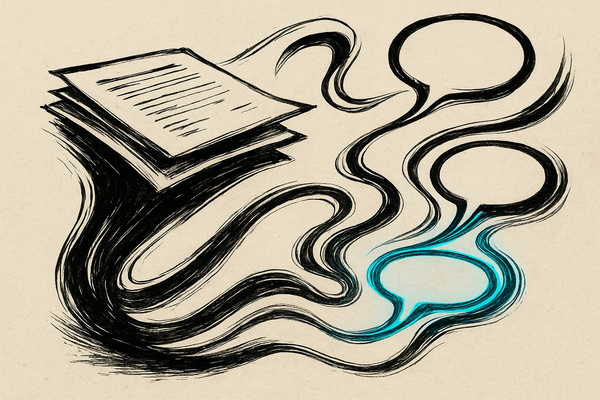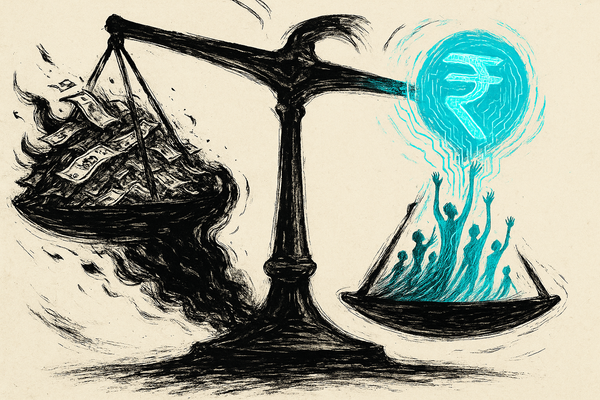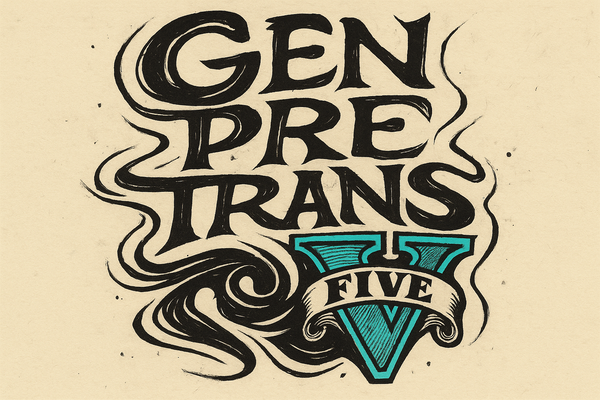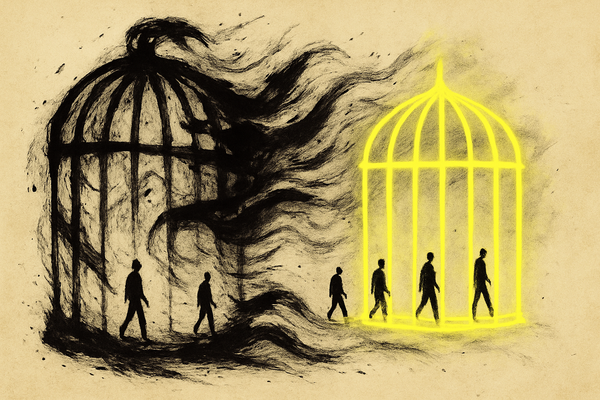ImaginEconomy Daily #8
In a world racing toward AI automation, the most successful marketing moments still happen in the well-orchestrated spaces between algorithms and intuition.

ImaginEconomy 🧠 ✨ 💰 : Brands, Strategy, Story and Design in the Age of AI
The Three-Second Test: Why Human Hooks Still Beat AI
Three seconds. That's all the time you have before viewers scroll past your content into digital oblivion. While most marketing technology companies are betting their futures on AI algorithms to crack the code of perfect video marketing hooks, Audio Network's Head of Branded Content UK, Kaitlyn Pearce, is placing her chips on something decidedly more analog: human intuition. Speaking at the Digital Marketing World Forum's panel on "The 3-Second Hook," Pearce revealed that despite 82% of listeners being unable to distinguish AI-generated from human-created music, the most effective video marketing hooks still require something machines can't yet replicate: cultural sensitivity and emotional intelligence.
ImaginEconomy Impact: The three-second hook isn't just about grabbing attention; it's about creating an emotional handshake that says "I understand you." While AI can analyze patterns in successful content, it struggles with the cultural nuance that makes a hook feel authentic rather than calculated. The winning agencies will be those that use AI to iterate faster while keeping human intuition at the helm of creative decisions. In an age of infinite machine generation, the ability to create genuine human connection becomes the ultimate competitive advantage.
Source: Marketing Tech News on video marketing hooks and human creativity
WPP's AI Declaration: "Transforming Everything We Thought We Knew"
WPP, the world's largest advertising holding company, has made its boldest AI statement yet: "AI is here to stay. It's disruptive. It's powerful. And it's transforming everything we thought we knew about marketing." The company has committed £300 million annually to AI investment, launching WPP Open—an AI-enabled marketing platform that connects people, tools, data, and intelligence. Through partnerships with Stability AI, Vercel, and IBM's watsonx platform, WPP is betting that the future belongs to agencies that can seamlessly blend human creativity with AI capability. The company's "vibe coding" approach allows creatives to build digital experiences using natural language prompts, potentially increasing development efficiency by 25%.
ImaginEconomy Impact: WPP's transformation reveals the new agency model: AI as infrastructure, humans as orchestrators. This isn't about replacing creative talent; it's about amplifying it exponentially. When the world's largest agency network invests £300 million in AI, it's not just adopting technology; it's redesigning the entire creative process. The agencies that survive will be those that can prove AI makes their humans more powerful, not redundant. But with every agency having access to similar AI tools, differentiation will come from the quality of human insight that guides those tools and weaves them together. The future belongs to agencies that can train their Human-AI operating systems to think as analytically as their best strategists, while reveling in the messy, uncomfortable process of human creativity, as well as making value judgments across both areas.
Source: WPP's AI transformation initiative
The Design Paradox: Balancing AI Precision with Human Authenticity
Marketing design in 2025 sits at a fascinating crossroads where probabilistic AI generality meets the craft renaissance. Franco agency's latest trend analysis reveals that while AI surrealism is becoming mainstream, especially for abstract concepts in mobility and tech, there's an equally powerful backlash toward precisely organic and humanistic approaches. Designers are strategically including flaws and rudimentary editing to match average user behavior, deliberately toning down polished content to feel more authentic. The trend toward 'bold minimalism' exemplifies this balance: using AI's capability for rapid exploration and iteration while maintaining the human touch that creates emotional connection.
ImaginEconomy Impact: This design paradox exposes a fundamental truth about the AI economy: perfection can kill conversion. As AI gets better at creating flawless visuals, audiences crave imperfection as proof of humanity. Smart designers are using AI for speed and volume while deliberately introducing human elements that signal authenticity. Rather than rejecting AI, it's about understanding that in a world where anyone can generate perfect imagery, strategic imperfection becomes a differentiator. The brands that win will be those that use AI to iterate faster toward work that feels more human, not less. It's the ultimate creative constraint: how do you use perfect tools to create imperfect experiences that feel real?
Source: Franco's 2025 marketing design trends
Microsoft's Cannes Revelation: AI as Muse and Multiplier
Microsoft's analysis of Cannes Lions 2025 reveals how AI is breaking creative barriers and making buying personal. The company highlights how Copilot and generative AI help brands personalize content, automate production, and overcome creative bottlenecks. Rather than replacing human creativity, AI serves as both muse and multiplier; inspiring new ideas while scaling successful concepts. Microsoft's data shows AI-powered campaigns can achieve higher engagement rates while reducing production timelines by up to 60%, but only when human strategists and creatives maintained critical oversight.
ImaginEconomy Impact: Microsoft's "muse and multiplier" framing perfectly captures AI's role in the creative process. It's not about human versus machine; it's about human with machine versus human without machine. The brands that dominated Cannes weren't those with the most sophisticated AI, but those that used AI to amplify their existing creative strengths. This validates our amplification thesis: the gap between AI-powered creativity and traditional creativity isn't just competitive advantage—it's survival. But the key insight is "muse and multiplier," not "master and commander." The winning formula keeps humans in the director's chair while AI handles the heavy lifting.
Source: Microsoft Advertising on Cannes Lions 2025 AI insights
The Marketing Talent Paradox: AI Might Create Jobs Instead of Destroying Them
New data from Robert Half reveals a stunning truth at least so far about AI's impact on marketing employment: marketing professional unemployment rates range from 2.4% to 3.8%, clearly below the 4.1% national average. Despite predictions that AI would eliminate all marketing jobs in short order, 91% of marketing leaders report struggling to find skilled talent, and 68% are planning to hire for new permanent roles. The demand spans customer experience, AI and machine learning, content marketing, and marketing automation, suggesting AI is creating more specialized roles, not fewer.
ImaginEconomy Impact: The talent paradox exposes AI as yet another technology: it might eat countless tasks but create demand for whole new jobs. As AI handles routine tasks, the value of human expertise can be multiplied. Marketing isn't being automated away; it's being elevated. The professionals in highest demand are those who can bridge AI capability with human insight, understanding both what technology can do and what it shouldn't do. This data proves our thesis: in the AI economy, competitive advantage comes from humans who know how to orchestrate intelligence, not from intelligence alone. The brands and agencies struggling to find talent aren't victims of AI disruption. They're beneficiaries of AI amplification who can't hire fast enough to meet demand.
Source: Robert Half 2025 marketing talent demand report
The Lo-Fi Creative Revolution: When Imperfection Beats Polish
A seismic shift is reshaping advertising creativity: 42% of top-spending ads now utilize lo-fi, low-production approaches that deliberately embrace imperfection over polish. Zero Gravity Marketing's 2025 Creative Trends Report reveals that audiences increasingly value authenticity and roughness over perfection, leading to unpolished aesthetics that mirror user-generated content, minimalistic production techniques, and conversational, unscripted dialogue. This trend represents more than cost-cutting. It's a strategic response to advertising fatigue in an era where perfection signals artificiality.
NOTE: ImaginEconomy's 'Inkcore Lucidity' illustration style has since the beginning been an exact manifestation of this hand-painted 'Lo-Fi' style. Even as it is purely AI generated—both at art direction and execution level.
ImaginEconomy Impact: The lo-fi revolution isn't about budget constraints—it's about trust constraints. In a world where AI can generate perfect imagery in seconds, imperfection becomes proof of human involvement. This trend reveals a shift in consumer psychology: perfection now signals deception or soullessness, while flaws signal authenticity. Smart brands are strategically "de-professionalizing" their content to rebuild trust with audiences who've become skeptical of overly polished executions. The winning creative strategy combines AI's efficiency with deliberate human imperfection. It's the ultimate irony: we're using perfect tools to create imperfect experiences that feel real.
Source: Zero Gravity Marketing's 2025 Creative Trends Report
Bottom Line: It's an Orchestration Economy
Today's stories reveal the emergence of something new: the orchestration economy, where value comes not from having the best AI tools, but from knowing how to conduct them in harmony with human expertise.
From three-second video hooks that still require cultural intuition to design processes that balance AI precision with strategic imperfection, the pattern is clear: AI amplifies human capability rather than replacing it. The marketing talent shortage proves this thesis. Even as AI can handle countless tasks, the demand for skilled human builders, orchestrators and AI managers may explode.
WPP's £300 million AI investment and Microsoft's "muse and multiplier" framework show how forward-thinking organizations are approaching this transition: AI as infrastructure, humans as conductors. The lo-fi creative revolution completes the picture, revealing that in an age of perfect AI generation, strategic imperfection becomes the ultimate differentiator.
The future belongs to brands brave enough to use perfect tools to create imperfect experiences that feel real, human, and trustworthy. In the orchestration economy, the conductors and players, both humans and agents, matter at least as much than the tools and instruments.
ImaginEconomy Daily Newsletter is curated for brand, business and marketing strategists, creatives, and leaders navigating the intersection of technology and human experience.




